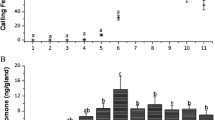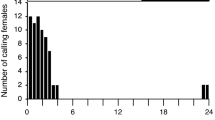Abstract
Adult male asparagus flies exhibit typical calling behaviors (suggestive of pheromone production) during which they emit a single volatile compound that was identified as isopropyl (S)-5-hydroxyhexanoate. In laboratory bioassays, synthetic samples elicited an arrestant response in females, but did not appear to attract females. On the other hand, the synthetic material attracted conspecific males in olfactometer bioassays.








Similar content being viewed by others
References
J. Auger S. Rousset E. Thibout B. Jaillais (1998) ArticleTitleSolid-phase microextraction-gas chromatography-direct deposition infrared spectrometry as a convenient method for the determination of volatile compounds from living organisms J. Chromatogr. A 819 45–50 Occurrence Handle10.1016/S0021-9673(98)00465-8 Occurrence Handle1:CAS:528:DyaK1cXmsFCgtLw%3D
M. A. Bateman (1972) ArticleTitleThe ecology of fruit flies Annu. Rev. Entomol. 17 493–518 Occurrence Handle10.1146/annurev.en.17.010172.002425
V. Casaña-Giner J. E. Oliver E. Thibout J. Auger (2001) ArticleTitleOn the pheromone of the asparagus fly, Platyparea poeciloptera J. Chromatogr. A 921 341–342 Occurrence Handle11471819
M. Dingler (1934) ArticleTitleDie Spargelfliege (Platyparea poeciloptera Shrank) Arbeit. Physiol. Angew. Entomol. 1 IssueID2 131–162
B. S. Fletcher T. E. Bellas (1988) Pheromones of Diptera E. D. Morgan N. B. Mandava (Eds) CRC Handbook of Natural Pesticides, Vol. 4. Pheromones CRC Press Boca Raton, FL 1–57
C. Gemeno K. F. Haynes (2000) ArticleTitlePeriodical and age-related variation in chemical communication system of black cutworm moth, Agrotis ipsilon J. Chem. Ecol. 26 329–342 Occurrence Handle1:CAS:528:DC%2BD3cXhsVKiurw%3D
C. Gemeno W. S. Leal K. Mori C. Schal (2003) ArticleTitleBehavioral and electrophysiological responses of the brownbanded cockroach, Supella longipalpa, to stereoisomers of its sex pheromone, supellapyrone J. Chem. Ecol. 29 1797–1811 Occurrence Handle1:CAS:528:DC%2BD3sXlsFynsrg%3D Occurrence Handle12956508
A. S. Hernandez A. Thaler J. Castells H. Rapoport (1996) ArticleTitleEnantiospecific synthesis of (+)- and (−)-ferruginine from l-glutamic acid. Synthesis of tropanes via intramolecular iminium ion cyclization J. Org. Chem. 61 314–323 Occurrence Handle1:CAS:528:DyaK2MXhtVSjs7zE
G. E. Keck J. A. Murry (1991) ArticleTitleTotal synthesis of (−)-colletol J. Org. Chem. 56 6606–6611 Occurrence Handle1:CAS:528:DyaK3MXmtlWqsbc%3D
E. Keinan K. K. Seth R. Lamed (1986) ArticleTitleOrganic synthesis with enzymes. 3. TBADH-catalyzed reduction of chloro ketones. Total synthesis of (+)-(S,S)-(cis-6-methyltetrahydropyran-2-yl)acetic acid: a civet constituent J. Am. Chem. Soc. 108 3474–3480 Occurrence Handle1:CAS:528:DyaL28XktVKgtrY%3D
P. J. Landolt R. R. Heath (1990) ArticleTitleEffects of pheromone release rate and time of day on catches of male and female papaya fruit flies (Diptera: Tephritidae) on fruit model traps baited with pheromone J. Econ. Entomol. 83 2040–2043
E. J. Lease S. M. McElvain (1933) ArticleTitleHydroxy and bromo esters derived from the hydrogenation of certain omega-acetyl esters J. Am. Chem. Soc. 55 806–808 Occurrence Handle1:CAS:528:DyaA3sXhsVamuw%3D%3D
P. Lesne (1913) ArticleTitleLa mouche de l’asperge aux environs de Paris Ann. Serv. Epiphyt. 1 228–247
U. Malher R. M. Devant M. Braun (1988) ArticleTitleReagent-controlled addition of (R)- and (S)-2-hydroxy-1,2,2-triphenylethyl acetate to chiral aldehydes Chem. Ber. 121 2035–2044
P. E. Pfeffer L. S. Silbert (1970) ArticleTitleα-Anions of carboxylic acids. I. Effect of hexamethylphosphoramide on metalation and alkylation J. Org. Chem. 35 262–264 Occurrence Handle1:CAS:528:DyaE3cXkt1Krtw%3D%3D
N. Pike A. Meats (2003) ArticleTitleTendency for upwind movement in the sibling fruit fly species, Bactrocerra tryoni and B. neohumeralis and their hybrids (Diptera: Tephritidae): Influence of time of day, sex and airborne pheromone Bull. Entomol. Res. 93 173–178 Occurrence Handle1:STN:280:DC%2BD3s7otFWnsg%3D%3D Occurrence Handle12699539
P. Reulet (1991) ArticleTitleAsperge: La situation phytosanitaire 1990 Phytoma-La Défense des Cultures 427 43–46
E. Seguy (1951) Ordre des Diptères P. P. Grassé (Eds) Traité de Zoologie, Vol. 10, fasc. 1 Masson Paris 449–744
J. Sivinski T. Burk (1989) Reproductive and mating behaviour A. S. Robinson G. Hooper (Eds) Fruit Flies: Their Biology, Natural Enemies and Control Elsevier Amsterdam 343–351
G. J. Steck (1984) ArticleTitleChaestostomella undosa (Diptera: Tephritidae): Biology, ecology, and larval description Ann. Entomol. Soc. Am. 77 669–678
S. R. Swier R. W. Rings G. J. Musick (1977) ArticleTitleAge-related calling behavior of the black cutworm, Agrotis ipsilon Ann. Entomol. Soc. Am. 70 919–924
E. Thibout J. Auger (1999) ArticleTitleSexual attraction and male pheromone evidence in the asparagus fly, Platyparea poeciloptera Entomol. Exp. Appl. 92 335–337
Acknowledgments
We thank E. David DeVilbiss of CAIBL for skillful mass spectral analyses. We are particularly grateful to Daicel, Inc., Tsukuba Research Center, 27 Miyukigaoka, Tsukuba City, Ibaraki 305, Japan; Daicel (USA), Inc., One Parker Plaza, 400 Kelby St., Fort Lee, NJ 07024, USA), and its U.S. representative Akira Isokawa, for a generous gift of (S)-5-chloro-2-pentanol. Mention of a proprietary product of company does not imply endorsement by the U.S. Department of Agriculture.
Author information
Authors and Affiliations
Corresponding authors
Rights and permissions
About this article
Cite this article
Thibout, E., Arnault, I., Auger, J. et al. Characterization of a Behaviorally Active, Gender-Specific Volatile Compound from the Male Asparagus Fly Plioreocepta poeciloptera. J Chem Ecol 31, 893–909 (2005). https://doi.org/10.1007/s10886-005-3551-y
Received:
Revised:
Accepted:
Published:
Issue Date:
DOI: https://doi.org/10.1007/s10886-005-3551-y




